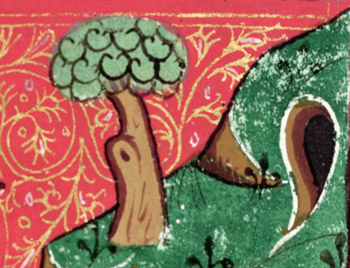Amoryus and Cleopes
General Information
Plot Summary

Amoryus and Cleopes are the children of two Roman kings reigning in Persia. Their parents live in adjacent palaces, but the pair has never met. When the pagan temple of Venus is destroyed by a storm, Cleopes’ father rebuilds it, to the delight of the citizens. Amoryus and his father, Palamedon, who are in Rome, are invited to the lavish consecration ceremony. Before departing, Palamedon makes a lengthy prayer to the gods and the planets. Then the two set off, accompanied by young knights who sing about love. On arrival they visit the temple and Palamedon commissions the priest of Venus to make a magical golden sphere. He does this with the help of spirits and the result, covered with mythological and astrological signs, is described at length. When he has finished, the priest shows it to Palamedon, but warns him that Venus has appeared in a dream and foretold the downfall of their religion.
During the consecration ceremony, Amoryus sees Cleopes and falls in love, but hides it from his companions. She reciprocates, and shows him an illumination in her prayer book. After the service, Amoryus acquires a kerchief with the same image as the illumination and wears it in the tournaments held to mark the occasion. He defeats all challengers, including a mysterious knight who wears the heraldic devices of many different countries.
One day, when Cleopes is in her father’s garden bemoaning her love, she discovers a crack in the wall, through which she spies Amoryus doing the same. The two exchange rings through the hole, each kissing their own side. Soon after, Amoryus leaves to fight a dragon in a nearby town and Cleopes gives him advice on how to win. When he returns victorious, the couple arrange to meet in the woods before dawn. But when Cleopes arrives early she is frightened by a lion and hides, dropping a kerchief on which the lion wipes its bloody mouth. Amoryus discovers the cloth and, bewailing the death of his love, stabs himself. Cleopes emerges and, when he has died in her arms, kills herself with his sword.
A Christian hermit hears her cries, and hastens to the scene. He prays to Christ and the Virgin and the lovers are resurrected, proclaiming their love for God and for one another. They return home to find the whole city in Venus’ temple, praying for their return. The hermit recounts the miracle, and dramatically banishes the demons that inhabit the image of Venus and the golden sphere. The crowd converts to Christianity and the hermit marries Amoryus and Cleopes in the temple, which he establishes as a church. After a long and successful life, the couple are buried in a splendid tomb. In the final 100 lines of the poem, Metham praises his patrons and discusses his reasons for writing.
From: Stephen F. Page, ed. Amoryus and Cleopes, by John Metham. Kalamazoo, Michigan: Medieval Institute Publications, 1999.
Manuscript: Princeton University Library, MS Garrett 141.
Manuscripts
Click a title below to search for all romances in that manuscript.